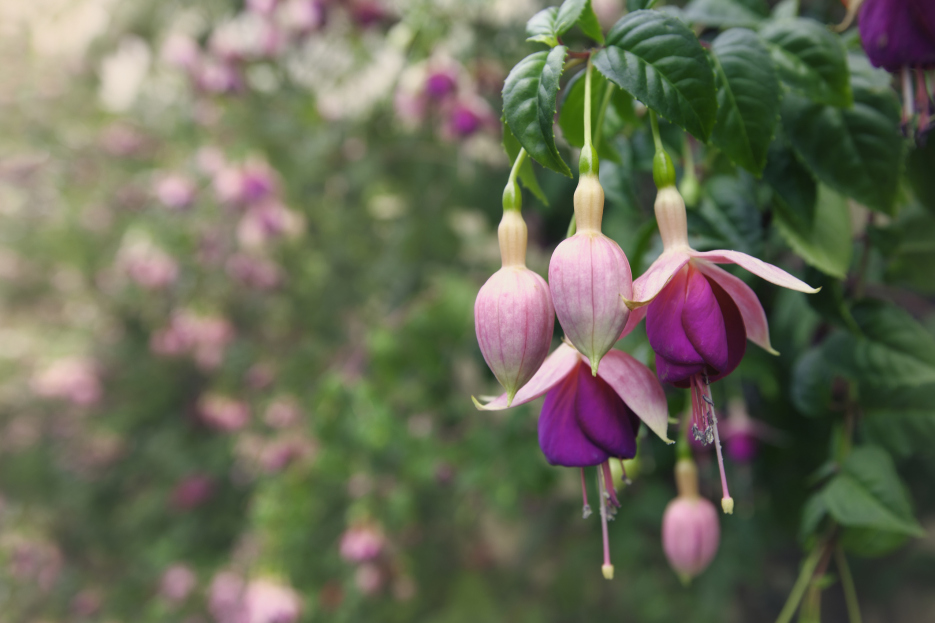
Fuchsia plants are known for their stunning, pendulous flowers that come in vibrant shades of pink, purple, red, and white. These plants are a favorite among gardeners and houseplant enthusiasts for their unique beauty and long-lasting blooms. Fuchsias can be grown indoors as houseplants, and with the right care, they can thrive and produce an abundance of beautiful flowers. Here’s a complete guide on how to care for a fuchsia houseplant.
Fuchsias thrive in bright, indirect light. While they enjoy a good amount of light, they do not tolerate direct sunlight, especially during the hottest part of the day, as this can scorch their delicate leaves and flowers. Place your fuchsia near a window with filtered light, or in a location where it will receive indirect sunlight for at least 4-6 hours a day.
If your fuchsia is placed in too much direct sunlight, the leaves may turn yellow or brown, and the flowers may wilt prematurely. On the other hand, if the plant does not get enough light, it may become leggy and produce fewer blooms. If natural light is limited, you can also use grow lights to provide the necessary light for your fuchsia.
Fuchsia plants prefer consistently moist soil but do not like to be waterlogged. Water your fuchsia when the top inch of the soil feels dry to the touch. Be sure to water thoroughly, ensuring that the water drains out of the bottom of the pot. Avoid letting the plant sit in standing water, as this can cause root rot.
During the warmer months (spring and summer), fuchsias may require more frequent watering, as they are actively growing and blooming. In the cooler months (fall and winter), you can reduce watering slightly, but still make sure the soil doesn’t dry out completely.
It’s important to water your fuchsia evenly to keep the soil consistently moist. If the plant dries out too much, the flowers and leaves may drop off. On the other hand, overwatering can lead to root rot, so always ensure the pot has good drainage.
Fuchsias prefer well-draining, slightly acidic to neutral soil. A good-quality potting mix designed for houseplants will work well, but you can also mix in some perlite or sand to improve drainage. The soil should be light and airy to allow for proper root growth.
When choosing a pot for your fuchsia, make sure it has drainage holes to prevent water from accumulating at the bottom. Fuchsias do not like to sit in water, and proper drainage is essential to prevent root rot. Repotting may be necessary every 1-2 years to refresh the soil and give the plant more room to grow.
Fuchsias thrive in moderate temperatures between 60°F and 75°F (15°C to 24°C). They are sensitive to extreme heat and cold, so it’s important to keep them in a location where temperatures remain relatively stable. Avoid placing your fuchsia near heat sources, such as radiators or air vents, as this can cause the plant to dry out.
In terms of humidity, fuchsias prefer a slightly humid environment. If the air in your home is dry, especially during the winter, you can increase humidity by placing a humidity tray under the pot or using a room humidifier. Alternatively, you can mist the leaves lightly with water to help maintain humidity levels. However, avoid wetting the flowers, as this can cause them to wilt prematurely.
Fuchsias are moderate feeders and will benefit from regular fertilization during their growing season (spring and summer). Use a balanced, water-soluble fertilizer (such as 10-10-10) or a fertilizer formulated for flowering plants. Fertilize your fuchsia every 4-6 weeks during the growing season to encourage healthy growth and abundant blooms.
In the fall and winter, you can reduce or stop fertilizing, as the plant’s growth slows down during the dormant period. Over-fertilizing during this time can lead to weak growth and fewer flowers.
Pruning and deadheading are important for maintaining the shape and health of your fuchsia plant. Regularly remove spent flowers (deadheading) to encourage new blooms and prevent the plant from becoming leggy. You can also prune back any long or unruly stems to keep the plant compact and bushy.
Pruning should be done in early spring or after the plant has finished blooming. Cut back any dead or damaged stems, and trim back the overall size of the plant if necessary. This will help promote new growth and more vibrant blooms.
Fuchsia plants are relatively pest-resistant, but they can occasionally attract aphids, spider mites, or whiteflies. If you notice small pests on the leaves or a sticky residue, check the plant carefully. You can treat pests by spraying the plant with insecticidal soap or neem oil, or by wiping the leaves gently with a damp cloth.
Fuchsias can also be susceptible to fungal diseases like powdery mildew, especially in humid conditions. To prevent fungal issues, ensure the plant has good air circulation, avoid overhead watering, and remove any infected leaves promptly.
During the winter months, fuchsias may slow down their growth and enter a period of dormancy. To help the plant through this time, reduce watering and keep it in a cool, well-lit location. You can also cut back the plant by pruning away any dead or damaged growth.
If you live in a region with cold winters, you can bring your fuchsia indoors to continue growing as a houseplant. Keep it in a location where it can receive plenty of light, but avoid placing it near drafts or heat sources. During the winter, the plant may not bloom as much, but with proper care, it will rebound in the spring.
Fuchsias are generally considered non-toxic to pets, making them a safe choice for households with cats and dogs. However, as with any plant, it’s always a good idea to monitor pets around your plants to prevent them from chewing on the leaves or flowers, which could cause mild digestive upset.